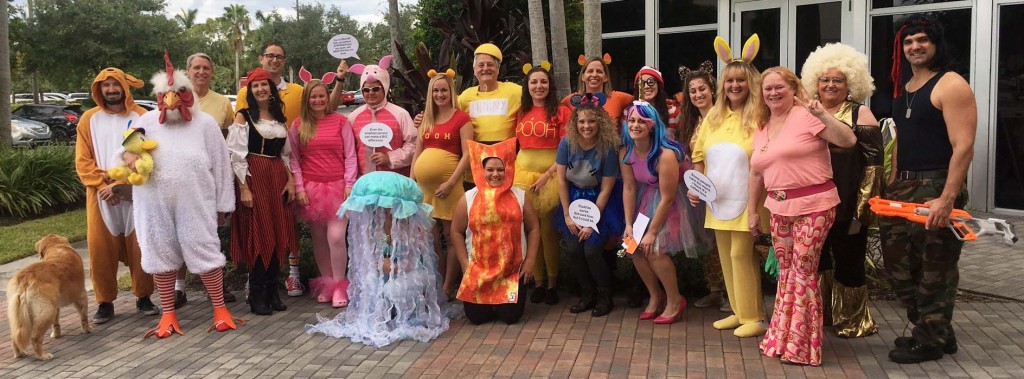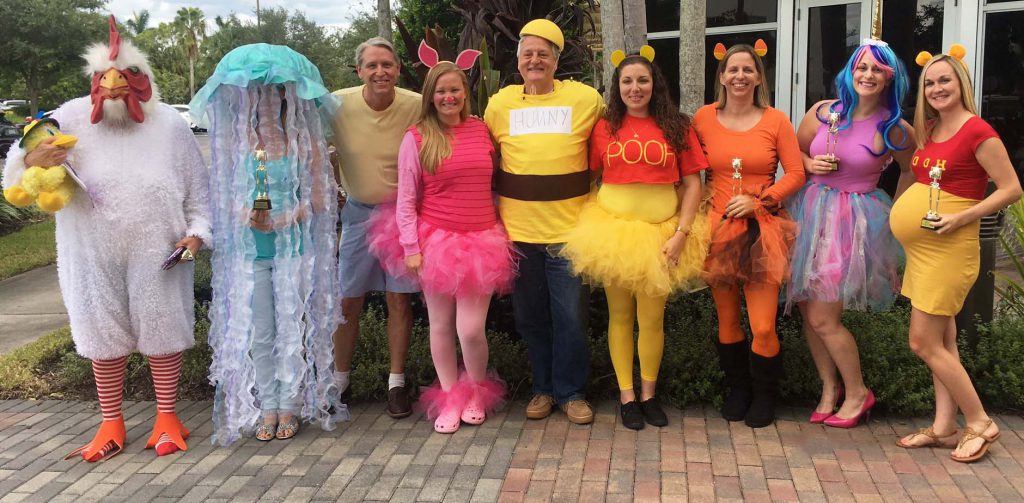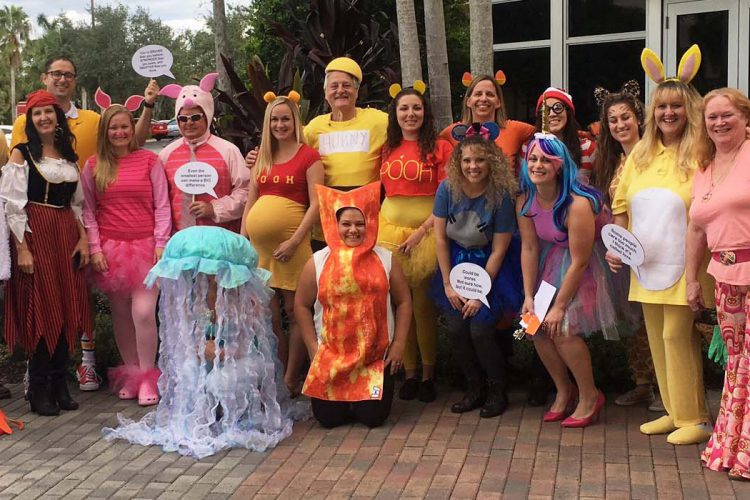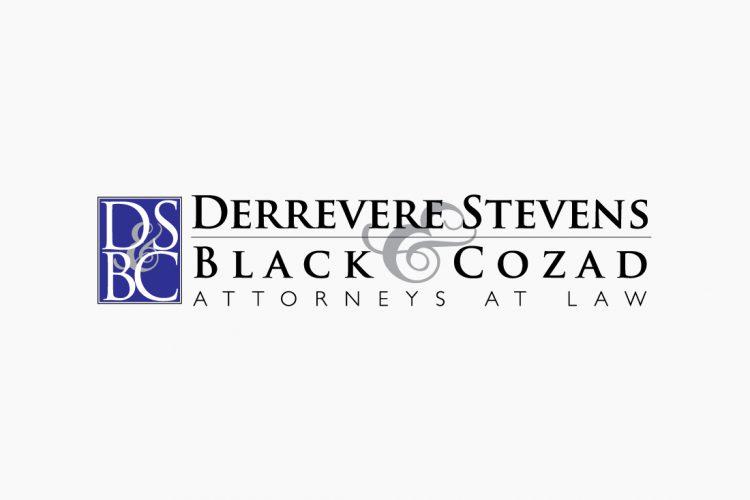November 7, 2017
DSBC Celebrated Halloween 2017

Every year, Derrevere Stevens Black & Cozad celebrates Halloween with an office costume contest.
Although unplanned, this year turned out to be “The Year of Winnie the Pooh.”
Both Michael Stevens’ and Jon Derrevere’s teams showed up to the office in Winnie the Pooh garb.
Everyone looked spectacular but as with any contest, there can only be one winner for each category.
Here they are…

(Pictured from left to right)
Funniest: Fran Minchew as Foghorn Leghorn
Best Overall: Candy Lobeck as a Jellyfish
Best Group: Jon Derrevere, Jamie Gordon, Bill Vertes, Jessica Mannix and Jennifer Bedner as Winnie the Pooh
Most Original: Jessica Mullendore as a Unicorn
Cutest: Mary Grecz as Winnie the Pooh
We hope everyone had a Happy Halloween!
November 2, 2017
Big Firm News!
The West Palm Beach-based law firm of Derrevere Hawkes Black & Cozad has recently changed its name to Derrevere Stevens Black & Cozad. Along with the name change, Michael B. Stevens has become the Managing Partner for the firm’s new satellite office in Boston, Massachusetts. Mr. Stevens manages the Insurance Subrogation and Real Estate Divisions for the firm.
In addition, Derrevere Stevens Black & Cozad would like to welcome Attorney Marjorie Levine to the firm. Ms. Levine is the sixth member of our Architect and Engineer Professional Liability Division.
November 1, 2017
Bryan Black to Speak at 2018 XL Catlin Adjuster Webinar
Attorney Bryan Black will be speaking at next year’s XL Catlin Adjuster Webinar.
Mr. Black will be speaking about Pre-Suit Mediation and Alternative Dispute Resolution Clauses.
September 13, 2017
Michael Stevens and Teddy Stevens to Speak at 2017 NASP Annual Conference
Michael Stevens and Teddy Stevens will be speaking at the National Association of Subrogation Professionals Annual Conference in Austin, Texas on November 7, 2017.
The title of the presentation is: Yes, but is it classy (ethical)?: A year in review of effective/ineffective communications and how to handle it with class. A re-education on how to communicate with each other in a way that is polite, respectful, effective, and especially – ethical.
Starting with ethical standards applicable to all attorneys, the session will go through real life anonymous examples of communications from the past year that show the highs and lows people have used to express themselves to opposing counsel, clients, third-parties, courts, the media, and others. This session will shed light on the dark side of poor communicators and help everyone handle those situations with more class, and in turn, greater success.
For more information, visit the event website.
April 21, 2017
Bryan Black Obtains Final Summary Judgment in Personal Injury Case involving claim against Architectural Company
December 7, 2016 – Smith v. Calvary, et al:
Counsel for Architect: Bryan W. Black.
This action arises out of personal injuries sustained by Plaintiff that occurred while Plaintiff was descending stairs in the center aisle of a theater on the Subject property.
Plaintiff sustained serious injuries to his legs which have led to multiple surgeries and extensive medical care. Plaintiff alleged that the Architect was negligent for failing to include handrails in its design of the center aisle in the theater.
At the time of Plaintiff’s fall, the design and construction of the property had been completed for more than four years, the Certificate of Occupancy had been issued and Owner had complete custody and control of the Property.
The Architect filed a motion for Summary Judgment based solely on the Slavin Doctrine. This doctrine stands for the position that liability is cutoff after the owner has accepted the work performed, if the alleged defect is “patent” which the owner could have discovered and remedied.
At the time of the hearing on Architect’s Motion, the only opposition asserted was from the Property Owner, who claimed the alleged dangerous condition asserted by Plaintiff was a “latent” defect. However, there was overwhelming evidence by way of correspondence to establish that the condition was open and obvious and Owner knew of and had previously discussed the stairs as a “safety concern”. These discussions included obtaining quotes for the installation of handrails, both before and after Plaintiff’s accident.
The Court granted Architect’s Motion holding (1) that Owner had standing to oppose Architect’s Motion and (2) that the alleged defect was patent and the Architect had no legal duty to Plaintiffs and cannot be found at fault or liable as a matter of law, citing Slavin v. Kay, 108 So. 2d 426 (Fla. 1979); Easterday v. Masiello, 518 So. 2d 260 (Fla. 1988).
After the entry of the Order Granting Summary Judgment, the Owner moved for Rehearing, which was denied.
April 21, 2017
Bryan Black Obtains Final Summary Judgment in Construction Defect case involving claim against Individual Architect
December 22, 2016 – 900 Biscayne Condominium Association v. 900 Biscayne, LLC, et al:
Counsel for Defendant Architect: Bryan W. Black.
This action arises out of claims asserted by 900 Biscayne Condominium against the Developer, Designers, Contractor and Subcontractors. 900 Biscayne, LLC (Developer) also filed cross and third party claims, including claims against certain individual Architects.
The Client, a principal of Architectural Firm, was one of the individually named architects sued in the action for professional negligence. The Client was not the Architect of Record who signed and sealed the Project design documents.
Final Summary Judgment was sought on the basis that under Florida Law, an officer, agent, member, manager or employee of a corporation of limited liability company is only professionally liable and accountable for negligent and wrongful acts of misconduct committed by that person, or by any person under that person’s direct supervision and control, while rendering professional services on behalf of the corporation. Fla. Stat. 621.07.
The Court found that the information submitted by the Developer, at best, established Client’s role was probably minimal in contract administration, but didn’t establish any violation of professional standards as an architect. The conduct claimed of is in the character of acting as a principal of Architectural Firm, as opposed to the acts of an individual architect in a professional capacity. Therefore, Final Summary Judgment was entered in favor of the Client as an individual architect, completely removing him individually from this action.
April 21, 2017
Bryan Black Spoke at 2017 AIA Conference on Understanding Ethics in Architecture
Attorney Bryan W. Black, an Allied Member of the American Institute of Architects, spoke at the organization’s Conference on Architecture on April 29, 2017 in Orlando, Florida. The event featured workshops, seminars, tours and events lead by industry-leading architects and design professionals.
Mr. Black, who represents architects and other designers throughout the State of Florida, participated in the conference alongside John Ehrig, FAIA and Martin Smith, AIA in a panel discussion titled “Let’s Make a Shady Deal: Understanding Ethics in Architecture.”
June 9, 2015
Jon D. Derrevere Obtains $800,000 Verdict for Client in St. Augustine Gas Station Explosion
After a two week jury trial, and three hours of deliberations, a six member St. Johns County jury found Florida Rock & Tank Lines, Inc. to be primarily at fault for the fuel spill, fire and eventual explosion that destroyed The 5th Wheel BP gas station owned by Coomes Oil & Supply, Inc., and neighboring businesses on August 19, 2011. The jury awarded Derrevere Hawkes Black & Cozad’s client Coomes Oil & Supply, Inc. $800,000 in damages.
Florida Rock & Tank Lines, Inc., sued Coomes Oil and J.B. Coomes to recover the loss of its gasoline tanker truck that was destroyed after in the fire and explosion that ensued. Coomes Oil and J.B. Coomes countersued Florida Rock & Tank Lines, Inc., for the fair market value of the gas station and costs incurred for debris removal and environmental clean-up.
Jon D. Derrevere argued, and the jury conclusively found, that the Florida Rock driver, David Cowles, failed to comply with mandatory safety regulations by parking too close to the above ground storage tanks, failing to verify the available safe fill capacity of the tanks, and not remaining within close proximity to the shut off valves while unloading fuel. The jury found that J.B. Coomes was not personally negligent for the explosion. After being personally exonerated, J.B. Coomes was very satisfied with the verdict.
A clip from the Coomes Oil’s closing argument can be found on the link below.
March 19, 2014
Michael Stevens to Speak at NASP Florida Conference on April 15, 2014
Michael B. Stevens will be presenting at the National Association of Subrogation Professionals’ Florida Chapter Meeting on April 15, 2014. Mr. Stevens will be speaking about Waivers of Subrogation and Subrogation Prohibitions in Florida. Click here to download a copy of the event’s flyer. If you have any interest in attending, please contact Kris Leal at 561.684.3222.
February 11, 2014
From the Premises Liability Corner: Plaintiff’s Burden of Proof and Discovery Issues
Effective July 1, 2010, Fla. Stat. 768.0755 provides that a business invitee, store customer, who slips and falls on a transient foreign substance in a business establishment must prove that the business owner had actual or constructive knowledge of the dangerous condition. In most cases, the plaintiff has difficulty proving the business owner had actual notice of the dangerous condition. Therefore, the issue is usually whether there is sufficient evidence to prove the business owner had constructive knowledge of the dangerous condition.
According to the statute, constructive knowledge may be proven by circumstantial evidence showing (1) the dangerous condition existed for such a length of time that in the exercise of ordinary care, the business establishment should have known of the condition or (2) the condition occurred with regularity and was therefore foreseeable.
Often times, the facts of a case will fail to establish the transitory substance existed for a sufficient amount of time to put the business owner on notice. In order to meet the statutory burden of proof, Plaintiff has no other choice but to prove the condition occurred with regularity and was thus foreseeable. Discovery issues often arise in this regard. In Publix Supermarkets, Inc. v. Santos, 118 So. 3d 317 (Fla. 3d DCA 2013), Plaintiff, a store customer, sued Publix for negligence and negligent mode of operation as a result of a slip and fall on “old wet spinach” on the floor near the cooking kiosk at a Publix store in Miami. Plaintiff sought discovery of all slips and falls near the kiosk at the particular store for three years prior to the accident. Publix served its discovery response which showed that no prior incidents occurred at the store. Plaintiff then sought to depose a Publix representative and requested production of all incidents reports relative to any occurrence at kiosks located in all Publix stores within the entire state of Florida. Publix objected and moved for a protective order contending that the burden of proof standard set forth in Fla. Stat. 768.0755 did not require it to produce the information. The trial court disagreed and Publix was directed to produce prior incidents at the subject store along with information as to all of the Publix stores statewide within the past three years. On appeal, the Third District Court reversed the ruling and held that under Fla. Stat. 768.0755, Publix only needed to respond to slip and fall incidents near the kiosk at the specific Publix store at issue and not as to all similar incidents at all Publix stores within the state of Florida.
Based on the foregoing, Plaintiff has a difficult path to travel in order to meet the statutory burden of proof as to actual or constructive knowledge of a dangerous condition. The statute and its interpreting case law greatly increases a favorable defense motion for summary judgment when there is no notice to the business owner of the transitory foreign substance. Derrevere, Hawkes, Black & Cozad has successfully argued and won summary judgment motions on behalf of its business establishment clients resulting in a cost effective and favorable result.


